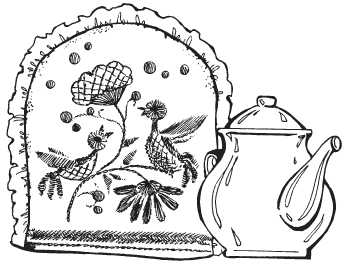You'll need
Flap light yellowish tone cotton or linen fabric size 70 X 120 cm; lining fabric dimensions 70 X 55 cm; foam dimensions 70 X 55 cm; filament floss in 3, 6 twists of orange, yellow, marsh green colors; embroidery needle; diagram of the pattern in full size; embroidery; tracing paper; transfer paper; pencil.
Progress
Hot water bottle is trimmed with frill of the same fabric. Embroidery is made with 2 sides warmers. We used the surface with "decks", braid, knots, loops with pakracani, polumetally with pakracani, overhead mesh, the seams are stalked, tambour, basketware, "back needle".
Of flap light cotton or linen fabric cut 2 semi-oval size 34 X 28 see the Rest of the fabric cut into strips for ruffles length 100 cm and width 4 cm. From lining fabric cut 2 of the same semicircle. 1 detail of the base fabric transfer motif with diagrams using tracing paper, copy paper and a simple pencil.
First and foremost, follow the birds. Their heads embroider orange thread in 6 additions glade the new stitches from the edge to the center. Beak make loops with pakracani yellow thread in 6 additions. Bring the needle with the working thread on the front side near the head and form a loop. Then pull the needle in the middle of the loops and make prakrama. Similarly, next follow the 2nd part of the beak.
The wings of a bird gladeville vertical embroider stitches thread orange. The middle of birds fill polypetalae with pakracani, they will perform exactly the same as the loops with pakracani. Each stitch should go from the top down. Tail make gladeville stitches with threads of orange color. Stitches lay across the feathers. Eye embroider knot thread swamp-green in 3 addition. Pulling a needle with thread in the middle of the head. Obviate the needle and working thread 3 times. Pull the knots to the tissue and tighten, pulling the thread on the wrong side. The second bird embroider in a similar way, but with a difference. The top half of the torso do the satin stitch and the lower stitch. First, make diagonal stitches from left to right, then top them perform the stitches from right to left.
The upper sepal of the flower of large fill stitch orange thread in 6 additions. The upper part of the flower embroider slip stitch. Make stitches at a slight angle in the form of 4 parallel lines. The contours of the flower panel seam "back needle" yellow threads in 3 addition.
The petals of the lower flower embroider glade-ment stitches of yellow thread, placing them along the petal. For parts use nodules from the orange thread in 3 additions.
Leaves fill stitch cross-stitches of different lengths, berries — surface "flooring". First, the edge of the berry panel simple stitches, and then make a "deck". Close it gladeville stitches, placing them across the "flooring". Thin twigs will perform stalked seam. The strands of embroider chain stitch.
At a distance of 4 cm from the bottom edge pull 2 threads of the fabric at intervals of 10 mm. At the pulled out threads do the basket stitch. Pull the needle on the front side and follow the 1st stitch from left to right. Then lay the 2nd stitch next to 1st right to left. It needs to be 2 times longer than 1st. Withdraw the needle to the front side at the point of the 1st stitch, having it under the fabric and pulling in the middle of the 1st stitch on the left side. Make the 3rd stitch from left to right. The remaining stitches will do the same.
A little below that seam embroider chain stitch yarns swamp-green hue. Next to the chain stitch make a loop — out of 9 stitches each. All stitches start with 1 center, they should be of different lengths. Semicircles make orange, yellow and swamp green threads alternately.
The long side of the strips fold 2 times on the wrong side and hem. Then gather it and sew the folds to the semi-circular cut details. Fold 2 pieces of main fabric together, right sides inside and sew a semi-circular direction. Turn on the front side. To detail of lining fabric sew the foam.
Stitch the 2 pieces, folding them right sides inward. Attach the lining in the bottle of the main fabric, fold the bottom edge and hem them concealed stitches (Fig. 89).

Figure 89. Warmer "birds" maker



